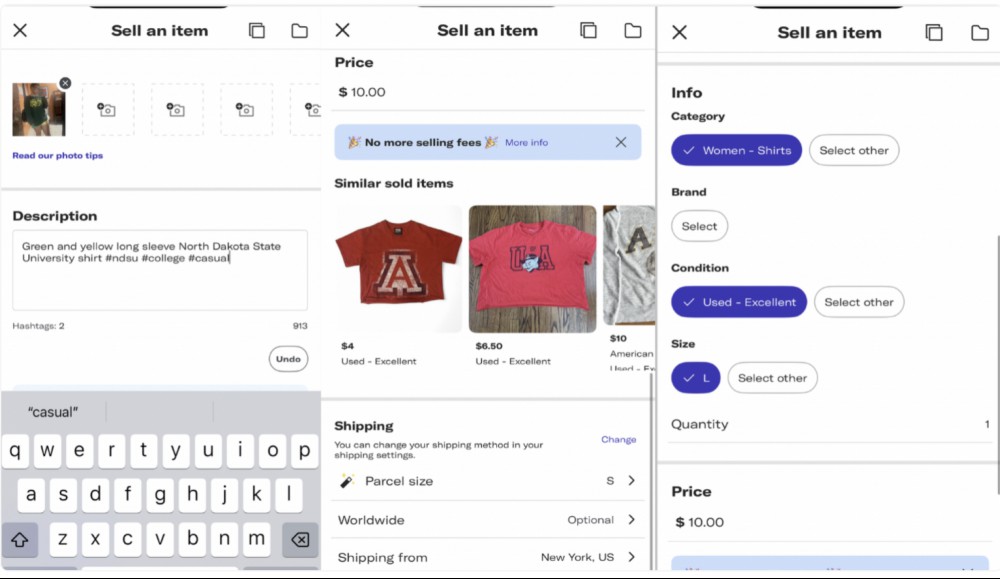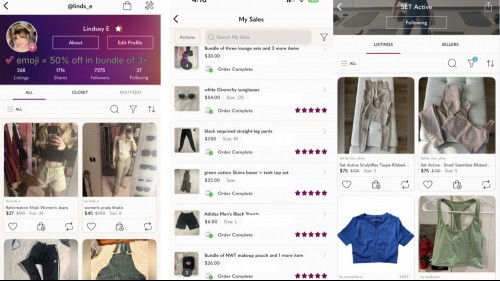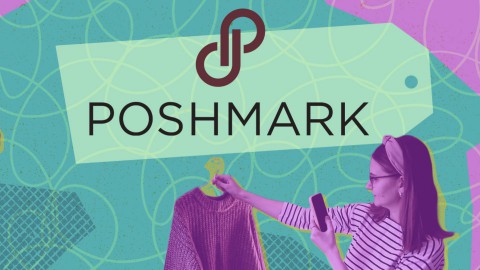I've been a dedicated user of resale apps for many years, both as a buyer and a seller (and these days, I'm using them even more, considering how useful they are in a post-tariff world). While some are more suited for luxury goods, like TheRealReal and Vestiaire Collective, others are for more general use.
Two of my favorites—and two of the most popular and widely used resale apps, period—are Poshmark and Depop. But which of these general use resale apps is best? On the surface, they seem pretty similar, but each works a little differently. If you're new to the resale game and wondering which is the better bet, allow me to share the hard-won expertise, illuminate their similarities and differences, and make my recommendation.
A general overview
Poshmark and Depop are both apps that make it extremely easy for everyday people to list and sell their stuff to other everyday people. The first difference you'll notice if you hit those links and look at their respective homepages is that Depop is much more fashion-forward. Poshmark, while it features a lot of clothing and accessories, is also foregrounds the sale of electronics, home goods, and knickknacks.
Creating a listing
The process of creating a listing is easy, whichever app you choose. From the home screen of either, you'll see a bottom menu with options. On Depop, they read Home, Discover, Sell, Inbox, and My Depop. On Poshmark, they say Feed, Shop, Sell, News, and Profile. Yup: Both apps have more or less the same five menu options, and in the same order.
To sell, you tap the middle icon, Sell, and on either app, you'll be prompted to upload pictures of your item, then taken to a screen where you'll fill out details about it that will be highlighted in the listing. There are some slight, but negligible, differences between the apps at this stage: Depop doesn't ask for a title, but does ask you to input the condition of the piece. Poshmark asks slightly more questions, like what you originally paid for it, and requires you to add a title to go along with the longer description both apps require.
Depop requires you to estimate the weight of the product, which determines what the buyer is charged for shipping, while Poshmark charges buyers a flat fee. Both have an AI feature you can toggle on that will scrutinize your uploaded photos and spit out a general description of what's in them. Both allow you to save unfinished listings as drafts. Generally speaking, the process of creating a sales listing is similar on both apps: easy.

Shopping the apps
Broadly, shopping these apps isn't quite like browsing Amazon, even if they don't differ from one another a great deal in terms of the buying experience. Hit Discover on Depop or Shop on Poshmark, type in a description of what you're looking for, filter results by brand and size, and sort based on factors like price or recency.
Both apps let you add your exact sizes to your profile, so you can shop exclusively for things that are most likely to fit you. Both let you send "offers" to sellers in lieu of paying a set price—these are suggestions for what you'd like to pay that the seller can agree to or dismiss. Say, for instance, you need a red dress for a party, find one you love on either app, but don't want to pay the $50 the seller is asking for. You can send an offer for $40 and, depending on their perception of the item's value and hurry to get rid of it, they can accept or decline.
An accepted offer on Poshmark automatically charges your card on file (or deducts from your in-app Poshmark balance generated from items you've sold), while an accepted offer on Depop still gives you the choice to move forward to the purchasing phase. Both apps also allow you to create "bundles" of items if a single seller has multiple items you want to buy. Sellers are much more likely to accept offers on bundles, as they're getting rid of multiple things with just one sale, so it's a good way to save money. Plus, you'll only have to pay for shipping once. Everyone wins.
Poshmark is sleeker; Depop is more fun
If I was describing the apps in terms of vibe, I'd say Poshmark has a slightly sleeker interface, while Depop gives off more of a party vibe. On Poshmark, your search results include a title, so you can see exactly what something is before you open its listing to further examine it; Depop just shows you a picture, the size, and the price, forcing you to tap on a listing to see things like the brand and description.
Shopping on Depop reminds me of browsing a trendy, curated thrift store: You're there to wander, and see what catches your eye, and typically, the goods on sale are spunky or unique—think a flashy vintage store run by an artsy girl with 100,000 Instagram followers.
Poshmark, on the other hand, is more of a catch-all marketplace: If you want clothes, obviously you'll find them there. But if you want a candle, you can buy a candle. I've sold everything from hair tools, to an Apple Watch, to a baseball bobblehead on my Poshmark store. In this way, it reminds me more of a small-town Goodwill, flush with the tchotchkes left over after someone's grandma died.
Which platform os better for shopping?
I'll be honest: I do most of my buying on Poshmark, but that's because I do most of my selling on Poshmark, and the app allows me to use my sales balance for purchases, giving me an easy opportunity to practice a one-in, one-out approach.
On either app you'll encounter a healthy mix of average sellers (people like me, who are just looking to offload the possessions they don't use anymore), and seasoned pros with thousands of listings, well-lit photos, and an actual expectation of making a real income from their marketplace use. There are pros and cons to buying from each kind of seller. In my experience, casual sellers are more likely to accept lower offers, and with some legwork, you can find a few who have the same taste, style, or sizes as you, and buy from them consistently. Professional sellers are more likely to have descriptive listings, useful photos, and a knack for actual customer service—meaning more responsive communication and prompter shipping.
Both apps have robust search features that help you find results for exactly what you're looking for, so the experience of shopping for something specific is similar across both.

In general, I have noticed Depop has a friendlier, less serious overall vibe. Maybe coincidentally, I have found some wild deals on otherwise-expensive pieces of clothing there that would likely be more accurately valued over on Poshmark. Depop is slightly folksier, if you're into that sort of thing: I get more deliveries from Depop sellers sent in custom, cutesy packaging (like pink envelopes) or including handwritten thank-you notes.
I find Poshmark sellers to be a little more straightforward about the business aspect of trading money for goods. (For what it's worth, as a seller on Poshmark, I've never included a thank-you note or a little bonus gift either.)
The answer to the question of which app you should buy on depends on what you want: If you want decor, a blouse, a collectible, or electronics, try Poshmark. If you want something trendy and fashionable, served up with a bit of whimsy, try Depop.
Which platform is better for selling?
Poshmark and Depop both provide the same ease of selling, with some minor differences. Both apps generate a QR code for your shipping labels, for instance, so you don't need to print and affix labels yourself; you just need to select a pre-paid envelope at the U.S. Post Office and show the desk clerk the code. That's a huge perk when it comes to shipping a lot of orders—and it's definitely not a feature of all resale apps.
Commission structure
Both apps require you to give a portion of your sale to the app (that's how they make money, obviously). Depop only takes 10% of whatever the sale and shipping cost are combined while Poshmark takes 20% of the sale price or, if you sell something for less than $15, a flat fee of $2.95. Buyers on Depop do pay a marketplace fee, which is up to 5% of the sales price plus another dollar, so keep in mind that if you're trying to sell on Depop, you might have to adjust your prices to make them appealing to someone who is already paying a variable shipping fee and marketplace fee on top of them.
Getting paid
Poshmark usually deposits your earnings into your balance within three days of item delivery (that is, when tracking shows your buyer has received it). Fom there, you can choose to keep the money in your Poshmark bank or transfer it to your bank-bank.
Depop processes payments either two business days after delivery, or 10 business days after the sale date, depending which comes first. Payouts can take up to five days to appear in your bank account.
Shipping costs
As noted, I've sold on both Poshmark and Depop, and found the process pretty seamless. Depop's pricing structure is a little unique, in that you, as the seller, must estimate the weight of the product and indicate it in the listing; what the buyer will pay for shipping is based on that estimate. On Poshmark, shipping is a flat rate of $8.27. If you're package costs more than that to ship, you'll have to eat the increase. (Though in my experience with 100 or so orders, this has happened to me maybe twice, to the tune of a few dollars each time.) On either app, you can offer shipping discounts, but you'll end up paying the difference out of your sales total for that too.
Dealing with buyers
Both apps allow for communication between buyers and sellers and periodically remind both parties to never conduct transactions off-app to avoid scams. I prefer selling on Poshmark because the shipping fees are well established, so potential consumers generally make buying decisions with the knowledge they'll be paying a flat $8.27 in mind. I also like selling there because it broadens my options. I can list not only clothing, shoes, and accessories, but workout equipment, picture frames, collectibles, makeup, electronics, and more.
You can certainly try to list other items on Depop, but there won't necessarily be an audience for it, since that app is so fashion-focused. Understanding the typical customer base on each app is crucial—you can list stuff all day, but if the average user of the app isn't logging in to look for those types of things, you're probably not going to see a lot of quick sales
Poshmark offers more selling tools
On both apps, you can run sales and promote listings to boost exposure, but Poshmark offers you way more opportunities to actually get your listings in front of would-be buyers. You can "share" your listings to your followers, so they appear on those users' home pages when they log in, and share listings to live show hosts who auction goods on in-app streams, QVC-style. You can also share to "Posh Parties," which are daily themed landing pages. Let's say you have a bunch of Adidas workout gear in your storefront. One day, the app might throw an "Activewear Posh Party." You'd be able to share those listings to the party and, as long as the party is ongoing, people who log into the app can see your goods on that landing page.
Poshmark rewards sellers a bit more, too. For instance, I've achieved "Posh Ambassador" status by selling at volume and receiving high ratings from buyers, which earned me a little badge on my page that signals to prospective buyers I'm a reputable seller. By maintaining a streak of listing at least once a week over an extended period of time, I also earn rewards like limited-time discounted shipping on my products.
All these tools come with a price, however: You have to actively engage with the app to make them work for you. I manually share my available listings to live shows at least once per day, which takes me 10 or 15 minutes each time, but I've automated everything else using an app called PrimeLister. PrimeLister shares my listings to my followers, shares other people's listings (which prompts them to share mine), shares relevant listings to Posh parties, and sends out automatic discount offers whenever someone "likes" one of my listings. But PrimeLister costs me about $30 per month, so if you don't want to pay that, you'll have to do all the work yourself. If you want to sell on Poshmark and anticipate making enough money to justify it, you should use PrimeLister, for sure.
Depop is more streamlined
Depop is a lot simpler. You list what you have, and if someone searches for it, they'll find it, but you're items won't be pushed out to anyone who isn't strictly searching for them. That's why it's generally better to only list things on Depop if they're trendy or desirable—there just isn't as high a likelihood of casual shoppers stumbling across your page.
Consider cross-listing
An option worth considering: Because I sell on both apps, I use a cross-listing tool called Vendoo to create my listings. After making the listings within Vendoo, I can send them out to multiple marketplaces—Poshmark and Depop, but also Vestiaire Collective, eBay, Mercari, and more.
The better resale app is...

Poshmark is the better choice for sellers
Because of its wider selection of wares, more straightforward shipping pricing, sleeker interface, and additional features, I do choose to sell more on Poshmark than any other app. That's not to say I don't enjoy Depop (especially as a buyer), but if I had to pick only one marketplace to continue using, it would be Posh.
While Depop is more laid-back, there are some issues that come with that approach. I've had more than one Depop order canceled because the low-volume seller "couldn't find" what I had bought. People on Poshmark generally are a little more business-minded, and it's rare that I wait more than three days for a purchase to be confirmed and shipped. Maybe it doesn't come with a cutesy thank-you note or a pink envelope, but I can count on my purchase to be delivered quickly, and with a predictable shipping cost.
If you're looking for that more personalized experience or an especially trendy item, certainly try shopping on Depop—and the same goes for if you want to sell something very on-trend. But if you want to sell or buy just about anything else, Poshmark is the better choice.
Covering productivity apps, home organization, and more.
